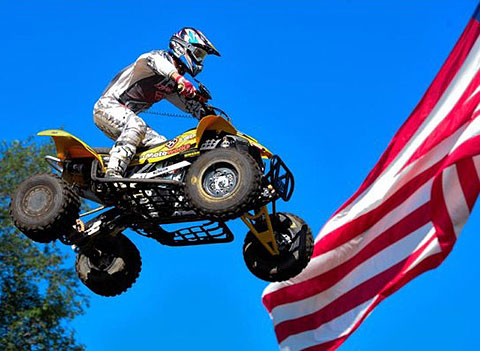The Official ATV Dictionary – Part 1

Know the Terminology Separating the Pros from the Squids
AATV: Amphibious All Terrain Vehicle; often containing six or eight wheels, this particular variety of ATV is known for its ability to operate on land or across water.
Aftermarket: Any ATV component that isn’t factory built (doesn’t come on a stock machine). Opposite of OEM.
ATV: All Terrain Vehicle; generic term used to blanket any vehicle designed to operate off road. Often referred to by other acronyms OHV (Off Highway Vehicle) or ORV (Off Road Vehicle).
Case: An ATV’s transmission; sometimes called casing. Also the term for when the rider misjudges the distance of a jump and ends up with the engine casing coming into direct contact with the ground.
CC: Cubic Centimeters; metric form of measurement used to calculate the volume of the amount of oil in the gearbox and the amount of space within the cylinder.
Compression: Suspension setting responsible for the rate at which shock fluid is able to pass through internal valving.
Digger: Generic term for any sort of crash. Also known as a Soil Sample, Get-Off, or Wreck.
Endo: Type of crash whereby the front of the ATV dips below the machine’s center of gravity. Occasionally the endo can be ridden out but more often results in pitching the rider over the bars. Opposite of a Loop Out.
Four-Wheeler: Generic term used to identify most modern ATVs from utility application to racing performance. Prior to 1987, three & four wheelers existed simultaneously in the domestic market.
Hardpack: Terrain condition in which the ground is dry and firm.
Holeshot: Racing term referring to the rider in the lead around the first turn at the start of a race.
Idle: The engine speed when the vehicle is not moving.
Inside Line: Racing term describing the inner-portion of a turn on a racetrack; or the inner curve of a turn. Opposite of Outside Line.
Line: Usually used in racing; this describes the path of the ATV as selected by the rider.
Loop Out: Type of crash whereby the rear of the ATV dips below the machine’s center of gravity. Most ATVs contain grab bars (small metal loops welded to the frame) to keep the machine from rolling atop its rider during a loop out. Opposite of an endo.
Marbley: Terrain condition in which small clots of dirt or stones litter a hard base.
Modified: Any ATV containing aftermarket parts or accessories, specifically in terms of the engine or suspension. Also refers to a racing class where only modified ATVs may participate.
Nose: Slang for the front of the machine.
OEM: Original Equipment Manufacturer; Components built by the company that manufacturers the machine itself. Opposite of aftermarket.
Off Camber: Terrain condition where the outside is sloped downward when traversed.
Outside Line: Racing term describing the outer-portion of a turn on a racetrack; or the outer curve of a turn. Opposite of Inside Line.
Pits: Outer section of most racetracks where riders park their ATVs when they are not competing.
Plastic: Generic term used to describe the fiberglass fenders and body pieces of an ATV.
Power Slide: Riding technique whereby the rear of the ATV is rotated using only the throttle.
Preload: Suspension setting referring to the amount of resistance being offered by the internal spring.
Quad: Slang term for the most common type of ATV; the four-wheeler.
Race Sag: A suspension term referring to the distance that the seat drops when a rider sits on the ATV. Used to correctly adjust suspension settings for rider’s weight.
Rebound: Suspension setting responsible for the rate at which a shock is able to extend after compression.
Rollover: Type of crash where the ATV tips onto its side or continues rotating multiple times due to momentum.
Roost: Short for Rooster-Tail; refers to the expulsion of soil and terrain as a result of the ATV’s spinning wheels.
Squid: An inconsistent and oftentimes dangerous rider. Sometimes called a Squirrel.
Static Sag: A suspension term used in conjunction with race sag (also known as Free Sag), it refers to the measurement of how much the suspension dips without the rider on board.
Stock: An ATV containing only factory parts (no aftermarket modifications). Also refers to a class of racing in which only stock ATVs may enter.
Stoppie: A trick whereby a rider pulls in the front brake causing the machine to rotate forward onto its front wheels. Also known as a nose-wheelie.
Swingarm: The pivoting support-section that connects the rear axle and shock absorber to the ATV’s frame.
Tail: Slang for the rear of the machine.
Three-Wheeler: Until 1987, the primary ATV of the United States and most of the world was the three-wheeler. Constructed similarly to the four-wheeler that would replace it, the three-wheeler had two wheels in the rear and only a single wheel up front. Other labels include Trike or ATC for all-terrain cycle.
UTV: Utility (all) Terrain Vehicle; more commonly called a Side by Side (SxS), the UTV is a 2-person or 4-person off-road vehicle; UTV can also stand for Utility Task Vehicle. Finally they are sometimes called ROVs for Recreational Off-highway Vehicles.
Yard Sale: Type of crash resulting in a trail of debris (broken components) left in the wake.
This is only part 1 of the definitive dictionary. What words have to be included in part 2? Voice your opinion here:
http://forums.atvconnection.com/general-chat/339151-atv-dictionary.html#post3054032
